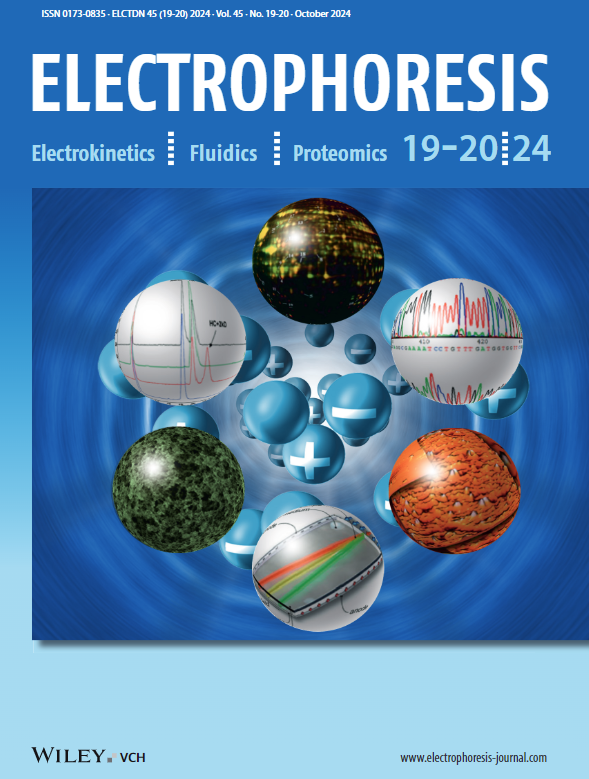Miniaturized nanoelectrospray interface for coupling capillary electrophoresis with mass spectrometry detection
IF 3
3区 生物学
Q2 BIOCHEMICAL RESEARCH METHODS
引用次数: 0
Abstract
A miniaturized electrospray interface consisting of a microfluidic nanosprayer and nanospray module is reported in the presented short communication. The nanosprayer was fabricated using silicon (Si) technology suitable for cost-efficient high-volume mass production. The nanospray module enabled the positioning of the nanosprayer in front of a mass spectrometry entrance and its coupling with capillary electrophoresis based on the liquid junction principle. A case study of top-down and bottom-up proteomic analyses of intact cytochrome c and its tryptic digest demonstrates the practical applicability of the developed interface.

用于毛细管电泳与质谱检测耦合的微型纳米电喷雾接口。
本短文报告了一种由微流控纳米喷雾器和纳米喷雾模块组成的小型化电喷雾接口。纳米喷雾器是利用硅(Si)技术制造的,适合成本效益高的大批量生产。通过纳米喷雾模块,可以将纳米喷雾器置于质谱入口前,并根据液体结原理将其与毛细管电泳耦合。对完整细胞色素 c 及其胰蛋白酶消化液进行自上而下和自下而上蛋白质组分析的案例研究证明了所开发接口的实际应用性。
本文章由计算机程序翻译,如有差异,请以英文原文为准。
求助全文
约1分钟内获得全文
求助全文
来源期刊

ELECTROPHORESIS
生物-分析化学
CiteScore
6.30
自引率
13.80%
发文量
244
审稿时长
1.9 months
期刊介绍:
ELECTROPHORESIS is an international journal that publishes original manuscripts on all aspects of electrophoresis, and liquid phase separations (e.g., HPLC, micro- and nano-LC, UHPLC, micro- and nano-fluidics, liquid-phase micro-extractions, etc.).
Topics include new or improved analytical and preparative methods, sample preparation, development of theory, and innovative applications of electrophoretic and liquid phase separations methods in the study of nucleic acids, proteins, carbohydrates natural products, pharmaceuticals, food analysis, environmental species and other compounds of importance to the life sciences.
Papers in the areas of microfluidics and proteomics, which are not limited to electrophoresis-based methods, will also be accepted for publication. Contributions focused on hyphenated and omics techniques are also of interest. Proteomics is within the scope, if related to its fundamentals and new technical approaches. Proteomics applications are only considered in particular cases.
Papers describing the application of standard electrophoretic methods will not be considered.
Papers on nanoanalysis intended for publication in ELECTROPHORESIS should focus on one or more of the following topics:
• Nanoscale electrokinetics and phenomena related to electric double layer and/or confinement in nano-sized geometry
• Single cell and subcellular analysis
• Nanosensors and ultrasensitive detection aspects (e.g., involving quantum dots, "nanoelectrodes" or nanospray MS)
• Nanoscale/nanopore DNA sequencing (next generation sequencing)
• Micro- and nanoscale sample preparation
• Nanoparticles and cells analyses by dielectrophoresis
• Separation-based analysis using nanoparticles, nanotubes and nanowires.
 求助内容:
求助内容: 应助结果提醒方式:
应助结果提醒方式:


